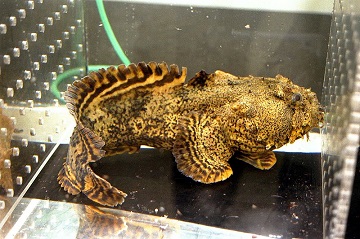600421 Noisy Fish.jpg

The male oyster toadfish call sounds like a foghorn. Credit: NASA
Anyone whose quiet afternoon at the beach has been disturbed by loud boats will feel sympathy for the male oyster toadfish. Boats can overwhelm its call to females. And it can get the fish all mixed up as well, causing it to change its call or even clam up for hours.
The oyster toadfish isn’t the most sympathetic looking creature in the sea. It’s about a foot long, with a big head, a body covered in mucus and warts, a powerful bite, and spines on its back that are venomous. It lives in shallow bays and estuaries, mainly around oyster reefs. It’s found along the East Coast, mainly from Cape Cod to Florida.
When it’s time to mate, the male toadfish builds a nest on the sea bed. When the nest is ready, the fish emits a loud call. It’s called a boatwhistle, although it sounds more like a foghorn.
The female swims over the nest of her selected mate and lays her eggs. The male watches over them until they hatch, then keeps an eye on the youngsters for a few weeks more.
A recent study, though, found that boats and other human-created sounds may disrupt that cycle. Researchers listened in to the calls of oyster toadfish in a saltwater pond on the coast of Massachusetts. They found that when boats were zipping through the pond, their engines overpowered the toadfish calls. The fish then changed their calls, or stayed quiet. The changes lasted for hours. So loud boats could keep toadfish apart -- perhaps cutting the populations of these ugly little fish.

